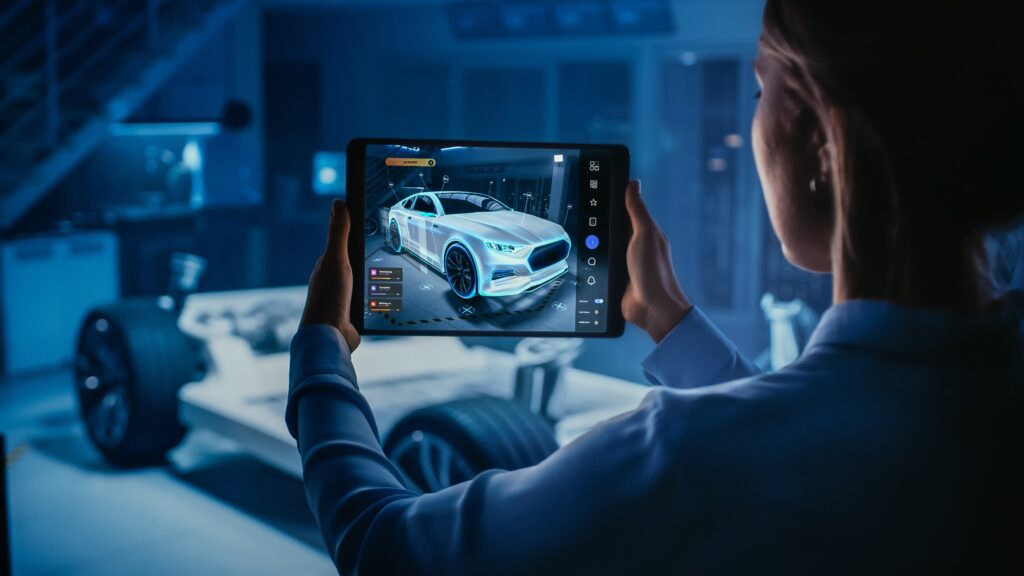Augmented Reality ar in automotive industry transforming the driving experience into something extraordinary. No longer confined to dull dashboards and static navigation systems, AR enhances visuals that seamlessly integrate with the driver’s surroundings, making every journey safer and more enjoyable.
As vehicles become smarter, AR bridges the gap between digital information and real-world driving, creating more intuitive, engaging, and personalized interactions. Fasten your seatbelts because we’re going to investigate how augmented reality is influencing driving habits.
What is AR and How Does it Work in Cars?
Augmented Reality (AR) is a technology that improves the user’s perception of their environment by superimposing digital information onto the actual world. When used in cars, AR uses cameras and sensors to gather information about the area around the car.
How AR Works in Cars
- Data Collection: AR systems in cars collect real-time data using various sensors and cameras that monitor the vehicle’s environment.
- Real-Time Processing: The collected data is processed immediately, allowing the system to generate relevant digital information.
- Information Projection: Crucial updates, such as navigation prompts or speed limits, are projected directly onto the windshield or a heads-up display. This design enables drivers to access important information without diverting their attention from the road.
- Enhanced Safety Features: AR enhances features like lane assist and collision warnings by visually highlighting lanes and obstacles, creating a more interactive and safer driving experience.
As machine learning and computer vision technologies advance, AR systems are expected to become even more sophisticated, providing immersive displays that adapt to the driver’s needs while prioritizing safety.
Benefits of AR in Driving Experience
Augmented Reality (AR) technology is revolutionizing the driving experience by providing a more intuitive and immersive environment for drivers. Here’s a deeper look into how AR enhances various aspects of driving:
- Improved Situational Awareness
Augmented Reality (AR) enhances drivers’ situational awareness by overlaying real-time information onto their field of vision. It alerts drivers to potential hazards, like pedestrians and cyclists, by highlighting these obstacles on the windshield, ensuring critical information is readily accessible for prompt reactions. Additionally, AR integrates data from vehicle sensors and traffic information to provide insights such as speed limits and traffic conditions in real-time. By keeping essential information within the driver’s line of sight, AR reduces distractions and fosters a more intuitive driving experience, ultimately contributing to safer roadways for all.
- Enhanced Navigation Systems
Augmented Reality (AR) is transforming navigation by projecting directions directly onto the road in real time. These advanced systems integrate live traffic data, highlighting turns, suggesting alternate routes during congestion, and providing information about nearby attractions or services. AR also makes obstacles, like pedestrians, more visible before they come into view. This interactive approach minimizes distractions, keeping critical information within the driver’s line of sight and enhancing decision-making while driving.
- Safety Features with AR Technology
AR technology is enhancing automotive safety by overlaying real-time information onto the driver’s view, significantly improving situational awareness. Alerts for potential hazards, such as pedestrians or sharp turns, are projected onto the windshield, helping drivers stay informed. Some AR systems also display vehicle diagnostics, like tire pressure and engine warnings, without requiring drivers to look away from the road. Additionally, AR assists with lane-keeping by visually indicating safe zones, helping prevent accidental lane departures. These innovations contribute to safer journeys for everyone on the road.
- Personalization and Entertainment
AR is elevating personalization in vehicles, allowing dashboards to adapt based on user preferences, such as highlighting favorite navigation routes or music playlists. It can also turn car windows into interactive screens for entertainment, displaying movies or games for passengers during long trips. With integrated voice and gesture recognition, adjusting settings becomes effortless. This combination of personalization and entertainment makes every journey more engaging, turning routine drives into memorable adventures tailored to individual preferences.
Future Possibilities of AR in the Automotive Industry
The potential of Augmented Reality (AR) in the automotive industry is vast, promising to reshape various aspects of driving, safety, and user experience. Here are some envisioned advancements:
- Vehicle-to-Vehicle Communication: Future vehicles will be able to communicate seamlessly through augmented reality (AR), sharing information about traffic and hazards in real-time. If a car detects a slippery road, it can alert the following vehicles, enabling drivers to adjust their speed or route accordingly.
- Real-Time Weather Updates: Envision driving with real-time weather updates projected directly onto your windshield. AR could enhance decision-making by displaying critical weather information, such as rain, fog, or icy conditions, enabling drivers to adapt their driving behavior and improve safety. This could be particularly valuable during adverse weather conditions, enhancing situational awareness on the road.
- Support for Autonomous Driving: As autonomous driving technology continues to evolve AR could bridge the gap between human input and machine learning. Visual cues projected in the vehicle could guide passengers, offering them insights into the route, points of interest, and upcoming changes in driving conditions. This seamless interaction could make autonomous travel more intuitive and engaging for passengers.
- Gamification of the Driving Experience: AR opens up opportunities for gamification within vehicle systems. While parked, drivers and passengers could engage in interactive experiences—like virtual racing games or augmented reality puzzles—making waiting times more enjoyable and productive. This could enhance the overall driving experience and create new forms of entertainment.
- Personalized Journeys: As AR technology advances, vehicles will offer highly personalized travel experiences, tailoring navigation, entertainment, and cabin ambiance to individual preferences. This personalization could turn ordinary commutes into enjoyable journeys.
- Immersive Travel Experiences: AR has the potential to redefine how we perceive travel itself. Imagine interactive narratives or educational content that passengers can engage with during their journeys, turning routine drives into immersive adventures. By overlaying historical facts, local attractions, or cultural insights onto the scenery outside, AR can enrich the travel experience, making each trip more informative and enjoyable.
The integration of augmented reality in the automotive industry will revolutionize driving by improving safety, engagement, and personalization, turning ordinary commutes into enriching, immersive experiences.
Challenges and Limitations of AR in Cars
While Augmented Reality (AR) offers vast potential in the automotive industry, several challenges must be addressed for successful implementation:
- Technology Integration: Integrating AR into existing vehicles can be difficult, especially for older models lacking the necessary hardware. Retrofitting can be costly while developing new AR-capable vehicles requires significant investment and time.
- User Distraction: AR systems risk overwhelming drivers with too much information, which can divert attention from the road. Developers must balance helpful cues with maintaining driver awareness to prevent accidents.
- Cost Implications: The high cost of AR technology, including advanced displays and sensors, may limit accessibility for budget-conscious consumers, leading to a divide in market offerings.
- Regulatory Issues: Rapid advancements in AR outpace regulatory frameworks, creating uncertainty regarding compliance and safety standards. Clear guidelines are needed to ensure safety while fostering innovation.
- Data Privacy and Security: The collection of personal and location data raises concerns about privacy and cybersecurity. Manufacturers must implement robust security measures to protect consumer information.
- Technological Reliance: Increased dependence on AR systems could diminish drivers’ skills and situational awareness, particularly if these systems fail or provide inaccurate information. Keeping drivers engaged and capable is essential.
Addressing these challenges will be crucial for the effective integration of AR in the automotive sector, paving the way for safer and more innovative driving experiences.






